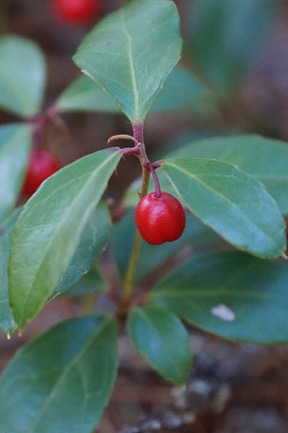Eastern spicy-wintergreen (Gaultheria procumbens)
Semi-woody, evergreen ground cover, arising from underground stems; long-lasting, fragrant, bell-shaped flowers followed by cherry-red fruit; distinctively scented leaves are appreciated by wildlife and humans. Found from Newfoundland to Manitoba, across the Midwest, and south to the higher elevations of Georgia.
 Maine’s deciduous forests declare their colors throughout much of October. The maples preside, but many species contribute to the autumnal pageant. November’s and early December’s colors are intermittent and elegiac; yet there are still vivid hues to be found, mostly among shrubs and ground covers, before snow obscures the landscape.
Maine’s deciduous forests declare their colors throughout much of October. The maples preside, but many species contribute to the autumnal pageant. November’s and early December’s colors are intermittent and elegiac; yet there are still vivid hues to be found, mostly among shrubs and ground covers, before snow obscures the landscape.
Younger oaks (Quercus species) and American beech (Fagus grandifolia) retain their leaves, the latter for most of winter. Both species can display rich shades of russet or burgundy before resigning to parchment-brown.
Huckleberries (Gaylussacia baccata), shrubs of acidic heaths, woodland openings, and barrens, usually keep their igneous colors, sometimes for weeks after their cohorts the blueberries (Vaccinium species) have been scoured of foliage. Then, once the huckleberries have relinquished their last leaves, it is possible to observe the extraordinary palette of the blueberries’ bare stems. In clonal pools on open ground there is every nameable shade of red, in addition to chartreuse, lilac grey, lime green, hazy purple, pink and orange. (These technicolor spectacles are produced on managed fields where competing vegetation has been reduced by burning or mowing, or eliminated on non-organic fields by herbicides.)
Hackmatacks (Larix laricina, our sole deciduous conifer) can still possess needles, into December if the weather obliges. These trees flare singularly golden in the low light of late autumn. In fruitful years like this one, winterberry (Ilex verticillata) billows with scarlet berries. Neon mounds against smoky branches, the fruits echo the colors of the birds who plunder the bushes in devouring flocks: cardinals’ reds, robins’ red breasts, waxwings’ rufous undertail coverts.
The hips of wild roses (Rosa carolina, R. virginiana) and the fruits of hawthorns (Crataegus species) gleam and glisten ruby-red along roadsides. Rusty red finials surmount the branches of staghorn sumac (Rhus hirta) whose summer growth throbs with color, even in dormancy, above older, tawny stems.
Some ferns express themselves in a final effort of sunny yellow or saffron before collapsing into a composting muddle. And there may be pools of bright gold where a birch has shed its leaves all at once, or orange rivulets of pine needles (Pinus strobus) coursing through the woods.
There is more color underfoot, provided by the abiding greens of a number of woodland perennials and ground covers. Some of these, like dewberry (Rubus hispidus) trail through leaf litter on ruddy, above ground stems; the plants leaves tint maroon and purple with colder temperatures. Partridge-berry (Mitchella repens) and twinflower (Linnaea borealis) are stalwartly green year-round except for partridge-berry’s signifying, pale mid-veins. Trailing arbutus (Epigaea repens) has larger, leathery leaves (and is a treasure to be found in any season). Goldenthread (Coptis trifolia, so-named for its cadmium-yellow roots) is another woodland gem that glitters glossy green. Prince’s-pine or pipsissewa (Chimaphila species) and the shinleafs (Pyrola species), one could call all these small evergreens the “present-tenseness of nature” — to poach the English poet Edward Thomas’s words — while much of the forest understory is past or future-imperfect.
Eastern spicy-wintergreen (Gaultheria procumbens) is, as Donald Stokes writes in A Guide to Nature in Winter, “a pleasure to know and find”.[1] Like dewberry, wintergreen’s polished blue-green leaves may blush a bit in the chill, but it is a true evergreen. Wintergreen’s leaves have a waxy cuticle protecting against the effects of severe cold. This armor prevents desiccation. Within the leaves, moisture can be sequestered to limit the damage caused by freezing and thawing. Photosynthesis is prolonged; sugars can be manufactured and transported as long as there is some sunlight, regardless of temperature.
Wintergreen was named for Jean-Francois Gaultier (1709-1758), a French naturalist and royal physician, sent to the colony of Quebec in 1742. Gaultier, in 1748, guided Per Kalm, Linnaeus’s emissary to the New World; and it was Kalm, in 1753, who honored the doctor’s botanical work with the genus Gaultheria. There are more than one hundred and thirty species of Gaultheria, most found in Asia, Australia and New Zealand, and in Central and South America. Five species of Gaultheria are North American, including the two species in Maine. Gaultheria procumbens, eastern spicy-wintergreen, can be found in pine and hardwood forests, in pine/oak woods, as well as in drier acidic soils. Gaultheria hispidula, snowberry or creeping spicy-wintergreen, is more common in cool evergreen swamps and boreal areas.
The abundance of common names for Gaultheria procumbens reflects both aboriginal and later usage of the plants. Tim Coffey’s Wildflowers lists over fifty regional names:[2] tea-berry, deerberry, chinks, young plantlets, and drunkards, traced to Massachusettes; in New Hampshire, one-berry, Jersey-tea, eyeberry, groundholly, ginger plum and jinks; young-come-up from Vermont; and in Maine, pippins, ivory-plum, youngster, little johnnies, and ivy leaves. “Kinnikinnik” is applied to both Gaultheria procumbens and Arctostaphylos uva-ursi (bearberry), an encompassing name for plants whose leaves were smoked and substituted for tobacco.
Wintergreen teas, made from well-steeped young leaves- Euell Gibbons suggested three days’ soaking before brewing- were administered for colds, rheumatism, pulmonary complaints, and used as blood tonics, and anthelmintics or vermifuges to expel tapeworms. Externally, wintergreen leaves and decoctions were made into poultices and liniments.
The plant’s flowers, leaves, and fruit all contain aromatic compounds, “as near ambrosia as anything our northern climate can produce”.[3] Oil of wintergreen is extracted from the young leaves, though a ton of leaves will produce only a pint of oil with terpene (and methyl salicylate). Clark’s original teaberry gum was flavored with wintergreen oil. Hikers still take advantage of wintergreen for some trailside dental hygiene, or a minty snack.
Wintergreen colonies are found throughout Maine’s woods and forest edges, sometimes in company with bunchberry (Chamaepericlymenum canadense). Both plants are considered shrubs, with their foliage clustered at the tips of short (two to six inches), slender stems that arise from roots running just below the soil surface. Wintergreen is a little more particular about soil than bunchberry, requiring acidity and humus. And wintergreen prefers some shade, although light is necessary to produce blossoms. Bumble bees (Bombus species) and cuckoo bumble bees (Psithyrus species) seem to be wintergreen’s pollinators.
There are few more fetching sights, in woodlands, than wintergreen which has sprung up in the long-decayed mound of an old stump. The leaves may hover above emerald mosses, braided with partridge berry. Wintergreen commonly grows out of “nurse logs”, the decomposing, nutrient-rich arboreal cadavers which, over time can look like miniature forests themselves. Various seeds are cached by birds, mammals and insects or urged by winds or enisled by rainwater. The seeds take hold in the fertile midden that an old stump or mouldering tree trunk represents. Fungi dismantle the wood, from within and without, and new lives begin among the rot. It is easy to imagine shrinking oneself, to enter the elfin world of the delicate vegetation that ensues. Wintergreen’s bright leaves and vivid fruit are often found in this forest microcosm.
Wild turkeys, grouse, black bears, white-footed mice, chipmunks, squirrels, deer and foxes all consume wintergreens persistent fruit. The plants leaves are starvation food for some wildlife in winter.
To propagate by seed, red fruits can be collected anytime in the fall or winter. (The fruit may not at first be visible: it dangles below the crown of leaves.) Squeeze the tiny seeds out of the flesh. The seeds can be stored dry in a sealed container until spring sowing as they need no cold period for germination. Sow seeds directly onto the surface of pre-moistened potting soil and put the pot in a dish of water to suck up moisture from below, or water very gently from above. Seeds usually germinate within a couple of weeks and are slow growing.
Commercial growers of wintergreen speed up this process by starting the seeds in a greenhouse under lights in the winter. Seeds are sown in a potting mix, covered with a clear plastic lid and put under grow lights. Check regularly for moisture needs and germination. Remove the lid once seedlings germinate. As the seedlings grow bigger they can be divided into clumps into pots. Pots can be moved outdoors in late spring pots to continue to grow and to acclimate.
By Pamela Johnson
[1] Stokes, Donald. 1976. A Guide to Nature in Winter. Boston: Little, Brown and Co.; p.363.
[2] Coffey, Tim. 1993. The History and Folklore of North American Wildflowers. Boston: Houghton Mifflin. pp.91-92
[3] Keeler, Harriet L. 1925. Our Northern Shrubs. New York: Charles Scribner’s Sons; p. 395.

